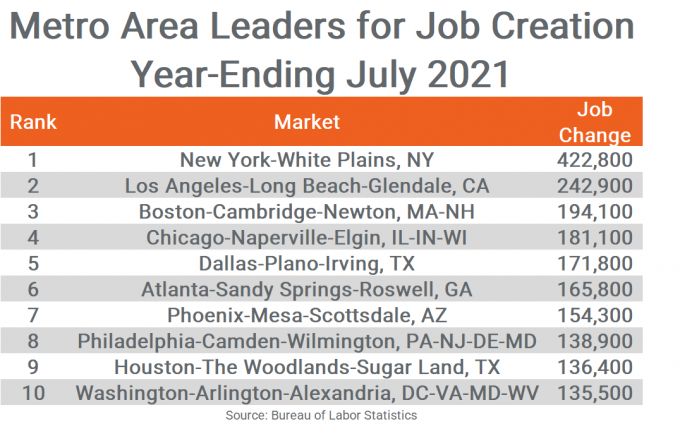Several of the top 10 markets for job gains in the U.S. added more jobs in the year-ending July than they did in June, according to data released by the Bureau of Labor Statistics (BLS). This uptick in job gains in half of the top 10 markets slowed the downward trend of combined gains that we have seen over the past several months. Still, we expect combined annual job gains to return closer to historical norms (between 500,000 and 600,000 jobs) among the top 10 markets by late 2021 or early 2022.

Nine of last month’s top 10 markets for job gains returned to July’s list, with several changing places. New York remained the top job generating market in the country, adding 422,800 jobs in the year-ending July 2021, almost twice the volume of the #2 market of Los Angeles with 242,900 jobs gained. While Los Angeles moved up two spots from last month, Boston remained at #3 with a gain of 194,100 jobs and Chicago slipped from #2 in June to #4 in July with a solid 181,100 jobs gained.
Dallas and Atlanta each jumped up two spots to land at #5 and #6 with gains of 171,800 and 165,800, respectively. Phoenix also leapt up the list to the #7 spot from #10 in June with a gain of 154,300 jobs. Philadelphia fell three spots to #8, adding 138,900 jobs in July, while June’s #6 – Washington, DC slipped to the #10 spot with a gain of 135,500 jobs. Houston replaced Detroit on the list of top job gain markets, coming in at #9 with 136,400 jobs added for the year.

Compared to February 2020 employment levels, all the top 10 job gain markets are still below their pre-pandemic employment levels. However, Dallas is on the verge of recovering all the jobs lost since the pandemic began. With only 10,900 jobs to go, Dallas is just 0.4% below the February 2020 job count. New York (-8.9%) and Los Angeles (-9.1%) have the most ground to make up, while the remaining top 10 markets are about 2% to 5% below pre-pandemic employment levels.
Thirteen of the 150 markets RealPage tracks have regained all the jobs lost during the pandemic and, except for Salt Lake City, are mostly small college towns. Austin is essentially back to pre-pandemic employment, just 300 jobs below February 2020 levels, while Kansas City, Knoxville, Jacksonville and Denver are all less than 1% below a full recovery. In addition to New York and Los Angeles, markets that still have a long road to full recovery include Midland/Odessa, Urban Honolulu, New Orleans, Orlando and Las Vegas. Each are still 9% or more below their February 2020 employment levels.
Comparing annual job gain on a month-over-month basis, about one-third of the 150 largest markets had higher annual job gains in July than in June as the remaining two-thirds continue to normalize closer to their historical trends. Houston, Los Angeles, Phoenix and Miami added at least 11,000 to 35,000 more jobs to their annual totals than the previous month’s annual gain. The biggest declines in annual job gains from June were in New York (-127,600), Philadelphia (-68,000), Detroit (-50,600 jobs), Chicago (-44,600 jobs) and Nassau County-Suffolk County, NY (-43,800 jobs).
These month-over-month comparisons of not seasonally adjusted labor data from the BLS can sometimes be misleading, but nonetheless give an idea of overall trends. In addition to the markets listed above, Washington, DC, Las Vegas, Boston and Minneapolis-St. Paul had declines of about 20,000 jobs or more compared to last month.
With the job gain spikes continuing to recede, 13 markets had annual job gains of 100,000 or more compared to 15 in June and 32 in April. Another 22 markets gained between 50,000 and 99,999 jobs, one less than June. None of the top 150 markets had an annual job loss from last July.
Annual percentage change in employment continues to be strong but with moderating job gains, the top performers have seen reduced job growth as well. Only half of June’s top 10 returned in July and June’s top percentage gain market of Las Vegas saw a reduction in job growth of 323 basis points (bps) to 9.5%, falling to third on the list.
Las Vegas, Providence and Anaheim were the only major markets in the top annual job growth market list, and all logged growth below 10%. Only the top market of Savannah, GA had a double-digit job growth figure (10.7%) in the year-ending July, as the remaining top growth markets ranged from 8% to almost 10%.

The weakest large markets for percentage growth had growth rates in the 3.5% to 4% range, while 62 markets ranged from 4% to 6% and 39 markets exceeded 6% growth (including the top 10). Only 15 small markets had employment growth rates of less than 3%.







